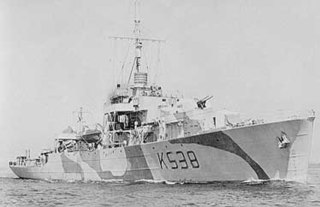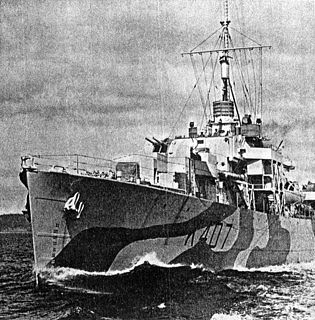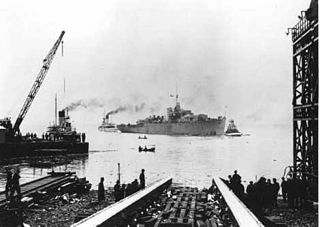
HMCS Toronto was a River-class frigate that served in the Royal Canadian Navy during the Second World War and as a Prestonian-class frigate from 1953-1956. She was named for Toronto, Ontario. She was later acquired by the Royal Norwegian Navy and renamed Garm and then again in 1965 as HNoMS Valkyrien.

HMCS Antigonish was a River-class frigate that served in the Royal Canadian Navy from 1944–1946 and as a Prestonian-class frigate from 1957–1966. She is named for Antigonish, Nova Scotia. Her photo is featured on the cover of the 1994 album Frigate by the band April Wine.

HMCS Cap de la Madeleine was a River-class frigate that served in the Royal Canadian Navy from 1944-1945 and as a Prestonian-class frigate from 1954-1965. She saw action in the Battle of the Atlantic as a convoy escort during the Second World War. She is named for Cap-de-la-Madeleine, Quebec, which is now a part of Trois-Rivières.
HMCS Fort Erie was a River-class frigate that served in the Royal Canadian Navy during the Second World War and as a Prestonian-class frigate from 1956-1965. She was named for Fort Erie, Ontario.

HMCS Penetang was a River-class frigate that served in the Royal Canadian Navy from 1944 to 1945 during the Second World War. She fought in the Battle of the Atlantic as a convoy escort. She was recommissioned and served as a Prestonian-class frigate from 1954 to 1956. She was named for Penetanguishene, Ontario.

HMCS New Glasgow was a River-class frigate that served in the Royal Canadian Navy during the Second World War and as a Prestonian-class frigate from 1955 to 1965. She was named for New Glasgow, Nova Scotia.

HMCS Beacon Hill was a River-class frigate that served in the Royal Canadian Navy (RCN) as an ocean convoy escort during the Second World War. She fought primarily in the Battle of the Atlantic. In 1954 she was converted to a Prestonian-class frigate and served until 1957. She was named for Victoria, British Columbia, but because HMS Victorious was in service with the Royal Navy, the RCN, in an effort to avoid confusion, chose to honour the city by choosing another name associated with it.
HMCS Lauzon was a River-class frigate that served with the Royal Canadian Navy during the Second World War and again as a Prestonian-class frigate from 1953-1963. During the war she served primarily as an ocean escort for convoys. She was named for Lauzon, Quebec.

HMCS Swansea was a Canadian River-class frigate that was the most successful U-boat hunter in the Royal Canadian Navy during the Second World War, having a hand in the destruction of four of them. She saw service in the Battle of the Atlantic from 1943 to 1945. Following the war she was refit as a Prestonian-class frigate. She is named for Swansea, Ontario.

HMCS La Hulloise was a River-class frigate that served with the Royal Canadian Navy during the Second World War and again as a training ship and Prestonian-class frigate from 1957–1965. She was named for Hull, Quebec, but due to possible confusion with USS Hull, her name was altered.

HMCS Prestonian was a River-class frigate that served with the Royal Canadian Navy during the Second World War and as a Prestonian-class frigate from 1953–1956. She saw action primarily as a convoy escort. She was named for Preston, Ontario, however due to possible confusion with HMS Preston, her name was altered. In 1956 she began service with the Royal Norwegian Navy as Troll.
HMCS Buckingham was a River-class frigate that served with the Royal Canadian Navy during the Second World War and as a Prestonian-class frigate from 1954–1965. She was named for Buckingham, Quebec. She is considered a significant part of Canadian naval history as used for some early trials of helicopter landings on smaller escort vessels. This led to the development of the future helicopter carrying destroyers.

HMCS Jonquière was a River-class frigate that served with the Royal Canadian Navy during the Second World War and again from 1954–1966 as a Prestonian-class frigate. She was named for Jonquière, Quebec.

HMCS Lanark was a River-class frigate that served with the Royal Canadian Navy during the Second World War and again from 1956–1965 as a Prestonian-class frigate. She fought primarily in the Battle of the Atlantic as a convoy escort. She was named for Lanark, Ontario.

HMCS New Waterford was a River-class frigate that served with the Royal Canadian Navy during the Second World War and then again from 1958–1966 as a Prestonian-class frigate. She served primarily in the waters around the United Kingdom as a convoy support escort. She was named for New Waterford, Nova Scotia.

HMCS Outremont was a River-class frigate that served with the Royal Canadian Navy during the Second World War and again from 1955–1965 as a Prestonian-class frigate. During the war she served primarily as a convoy escort. She was named for Outremont, Quebec.
HMCS Stettler was a River-class frigate that served with the Royal Canadian Navy during the Second World War. She served primarily as a convoy escort in the Battle of the Atlantic. She was named for Stettler, Alberta. After the war she was converted to a Prestonian-class frigate and served until 1966.

HMCS Ste. Therese was a River-class frigate that served with the Royal Canadian Navy during the Second World War. She served primarily as a convoy escort in the Battle of the Atlantic. She was named for Sainte-Thérèse-de-Gaspé, Quebec. After the war she was converted to a Prestonian-class frigate and served until 1967.

HMCS Sussexvale was a River-class frigate that served with the Royal Canadian Navy during the Second World War. She served primarily as a convoy escort in the Battle of the Atlantic. She was named for Sussex, New Brunswick. Her name was altered to prevent confusion with other Allied warships named Sussex. After the war she was converted to a Prestonian-class frigate and served until 1966. She was the last frigate launched by the Royal Canadian Navy during the Second World War.

HMCS Victoriaville was a River-class frigate that served with the Royal Canadian Navy during the Second World War. She served primarily as a convoy escort in the Battle of the Atlantic. She was named for Victoriaville, Quebec. After the war she was converted to a Prestonian-class frigate in 1959. In 1966 she was converted to a diving tender and renamed Granby, serving as such until 1973 when she was decommissioned for the final time.















